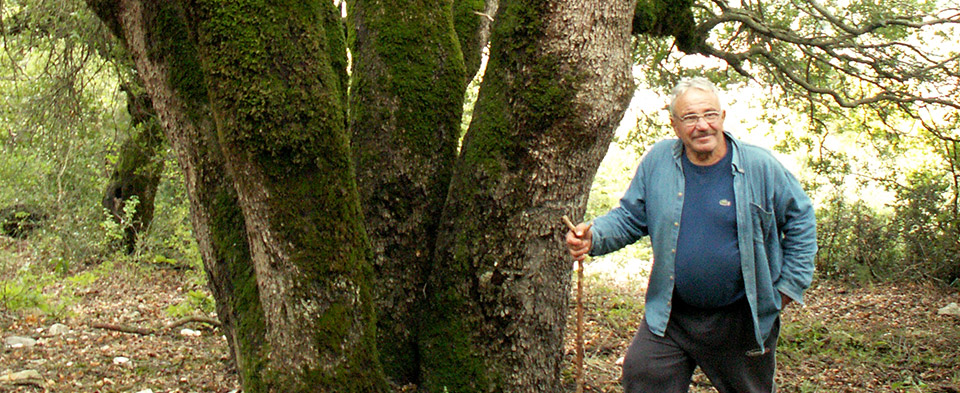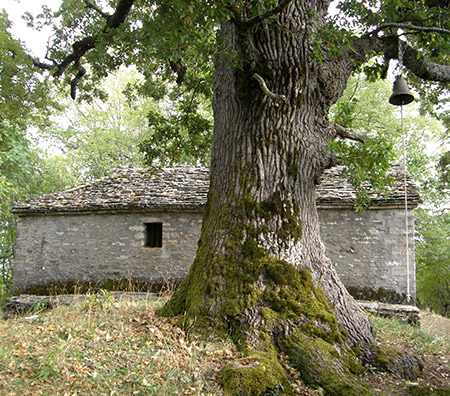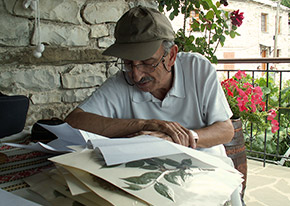A net Sacred náttúrusvæða er að finna í Zarori, svæði á fjöllum sviðum Norðvestur Grikklandi. Þetta eru annaðhvort hlífðar skógar eða Groves á fjallinu brekkur ofan þorpum eða hópa öldungur trjám um kapellur. Andlegar undirstöður þeirra og viðhald hafi verið túlkað sem leið stjórnun staðbundnum auðlindum og vistkerfum í trúarlegum reglum. Heilög tré og lundir hafa verið tengd bannorðum um tréskurð, til dæmis varðandi yfirnáttúrulegar refsingar. Í fortíðinni, þessi staðbundnu aðlöguðu stjórnunarkerfi stjórnuðu notkun samfélagsins á vistkerfaþjónustu. Þær þjónuðu líka sem síðasta úrræði þegar á þurfti að halda eða sem vörn fyrir þorpin gegn náttúruvá.
Ekki háð vernd; Vaxandi ógn(er), gæti orðið í hættu í framtíðinni, möguleiki á verulegu tjóni er fyrir hendi.
Á 20. öld og sérstaklega eftir síðari heimsstyrjöldina, Breytt mynstur landnotkunar og fólksfækkun hefur haft gríðarleg áhrif á samfélagsgerðina, stjórnunarhættir og menningarlandslag í dreifbýli Grikklands. Hrun staðbundinna stjórnunarkerfa var vegna tilkomu nútímavæðingar og afskiptaleysis miðstýrðra yfirvalda. Það hefur valdið því að heilagir lundir hafa verið niðurlægðir og ógnað hvar sem þeir stanguðust á við kröfur nútímans. Þrátt fyrir þetta, heilög svæði njóta áfram virðingar af staðbundnum samfélögum og þau eru enn mikilvægur hluti af sjálfsmynd eldri kynslóðarinnar.
Vörsluaðila
Helgustu stöðum á svæðinu eru litið eftir af heimamönnum. Í fortíðinni var Zarori búið af Zagorians sem stofnuðu þorpin og tungumálalega aðgreinda Vlachs. Pastoral transhuman Sarakatsani en einnig sígaunar og aðrir farandmenn sem voru starfandi sem verkamenn heimsóttu svæðið. Sameiginleg áföll og fólksfækkun, sérstaklega á 20. öld, hafa rýrt þjóðernisaðgreiningu og í dag fellur „Zagorian“ heitið alla þjóðernishópa inn í vaxandi sjálfsmynd sem er skilgreind af Zagori sem uppruna- eða búsetustaður.
Allir íbúar eru Orthodox kristnir. Viðhorf um heilagt tré og Groves eru, þó, fyrst og fremst í tengslum við leik-Christian hugmyndir. Þroskuð tré til dæmis, litið á sem djöfullegar verur eða ásóttar af slíkum verum og geta þannig skaðað þá sem reyna að skaða þær. Slík staðbundin viðhorf eru ýmist endurtúlkuð í ríkjandi trúarbrögðum eða eru óformlega samhliða henni.
Framtíðarsýn
Nú tabú eru að hverfa ásamt eldri kynslóð. Þættir þessara tabú hefur hins vegar verið haldið með tilliti til sögu samfélag og hefðir. Framtíðarsýn okkar er að heilög náttúrusvæði séu viðurkennd sem staðir með andlegt og sögulegt gildi fyrir yngri kynslóðir. Við stefnum að því að þeirra menningar, fagurfræðilegir og vistfræðilegir eiginleikar eru varðveittir og þeim stjórnað á fullnægjandi hátt.
Heilagir lundir eru lítt þekktir, jafnvel í Grikklandi nútímans. Átakið til að kanna þá í Zagori hófst í 2003 og hefur verið haldið áfram síðan með fjárhagslegum stuðningi frá ýmsum áætlunum um gríska Umhverfisráðuneytið og ESB. Háskólinn í Ioannina (Uou) hefur tekið þátt síðan 2005. Nýtt þverfaglegt verkefni með aðsetur hjá UOI „Conservation through Religion: hinir helgu lundar í Epirus“ ("SAGE", 2012-2015) miðar að því að rannsaka lífmenningarlegt gildi þeirra í samhengi við árangursríka verndun. Alls 38 félagsleg og náttúruleg vísindamenn frá Grikklandi og erlendis mun taka þátt. Sveitarfélagið hefur einkum sýnt þessu átaki jákvæðan áhuga.
"Trúarbrögð okkar eru lifandi. Ég hef séð Agia Paraskevi. Hún var að hrópa. Ég var barn af 16 ár, síðdegis, það var rigning. Ég átti leið hjá fyrir ofan klaustrið. Og undir klaustrinu höfðu nokkrir þorpsbúar fjarlægt fallnar trjágreinar úr heilaga lundinum hennar. Og hún var að hrópa: „Nei, ei“ og fór fólkið úr skóginum og hljóp á brott. Ég gekk inn í kirkjuna, enginn var inni. Ég lagði krossinn minn og ég held áfram leið minni. Ég hef greinilega heyrt hana." - Dimitris Paparounas (Íbúi í Ano Pedina þorpinu, tekið viðtal í 18/9/2006.)
Á svæðisvísu, opinbers fyrirlestrar, rit í staðbundnum tímaritum og aðgerða á öldungur-tré stjórnun hafa átt sér stað. Þessi starfsemi miða að því að auka vitund almennings um Sacred Natural Sites og öldungur tré. Menningarfélög sveitarfélaga taka mjög jákvætt við þessum hugmyndum og eru fleiri viðburðir fyrirhugaðir á næstunni.
Vísindastarf á innlendum og alþjóðlegum vettvangi heldur áfram með þátttöku í ráðstefnum, fræðileg rit og samstarf við alþjóðlega vinnuhópa eins og IUCN (Sérfræðihópur WCPA um menningarleg og andleg gildi verndarsvæða) eða the Delos Initiative.
Þar sem 2000, þátttökutækni sem fundin var upp af félagsvísindamönnum, þjóðfræðingar og vettvangsvistfræðingar hafa verið notaðir við könnun og kortlagningu á helgum lundum Zagori. 173 heimamenn hafa tekið þátt í þessum rannsóknum. Flestir uppljóstrarar voru eldra fólk. Um sumarið 2009 a ljósmyndasýning Andre Bakker vakti athygli á málinu. Þessar aðferðir eru nú framlengdar í gegnum SAGE forritið, til dæmis könnun á líffræðilegum fjölbreytileika SNS, með áherslu á sérstaka flokkunarhópa (flóra, fuglar, geggjaður, fléttur, sveppir, skordýr).
Stefna og lög
Heilagir lundir í Grikklandi, eins og í mörgum öðrum löndum heims mynda að mestu óþekkt „skugga“ verndarnet. Á stofnanastigi grísk löggjöf, verndar aðeins 51 Náttúruminjar um einstök tré eða lundir með sérstakri grasafræði, vistfræðilegar, fagurfræði, sögulegt eða menningarlegt gildi. Þetta skilur að minnsta kosti 99 % af grísku helgu náttúrusvæðunum opinberlega óvarið. Þessar minjar voru friðlýstar á milli 1972 og 1986, undir N.D. 86/1969 skógarlaga, en vegna breytinga á stofnanastigi og hægfara skrifræðiskerfisins, allar yfirlýsingar um náttúruminjar verða fyrir miklum töfum.
Sem afleiðing af þjóðfræðirannsóknum, skoðanakannanir og kynningar margir staðbundnir fulltrúar menningarsamtaka þorpa hafa leitað til þessa framtaks og beðið um leiðir til að auka vitund og verndun á helgum náttúrusvæðum svæðisins.. Fólk biður líka um hagnýt ráð til að stjórna heilögu öldungartrjánum í þorpum sínum á fullnægjandi hátt.
"Áður fyrr vígðu margir akrar og víngarða kirkjunni. Gamla dömurnar sem voru vanar að hjálpa til við ræktun við að grafa víngarða voru að segja: „Hristu skóna þína til að taka ekki hið heilaga land með þér“. Jafnvel jarðvegurinn sem þeir vildu ekki taka ... Það var virðing, nú er virðingin horfin." - †Athina Vlasou (1922-2010), búsettur í Dilofo þorpinu, tekið viðtal í 10/7/2006.
- Kyriakidoy - Nestoros, A. (1989). Laografika meletimata (Þjóðsagnafræði) ég. Félag hellenska bókmennta- og söguskjalasafnsins, Athens [á grísku].
- Lagopoulos, A.F. (2002). O ouranos pano sti gi. Teletourgies kathagiasis tou ellinikou paradosiakou oikismou kai proelefsi tous (Himinninn yfir jörðinni. Helgiathafnir í hefðbundnum grískum byggðum og uppruna þeirra). Odysseas útgáfur, Athens [á grísku].
- Nitsiakos, V. (2003). Chtizontas að choro kai til chrono (Að byggja upp stað og stund). Odysseas útgáfur, Athens [á grísku].
- Old, K., Tsiakiris, R. og Wong, J. (2012). Heilög tré og lundir í Zagori, Northern Pindos þjóðgarðurinn, Grikkland. Í: Pungett, Gl., Oviedo, G., Hooke, D. (EDS). Sacred Tegundir og Síður. Framfarir í Biocultural verndun. Cambridge University Press, U.K.
- Old, K., Tsiakiris, R. (2010). The "Meadows" það voru "skóga": Málið um verndarskóga Zagori, NW Grikkland, PP. 57-62. Í: Sidiropoulou, A., Mantzanas, K., og Ispikoudis, ég. (EDS). Málflutningur 7. Panhellenic Rangeland Congress í Xanthi, 14-16 Október 2010:„Umfangsvísindi og lífsgæði". Umhverfisráðuneytið, Orka og loftslagsbreytingar., Framkvæmdastjóri og verndun skóga og náttúru & Hellenic haga- og sviðafélag, Þessalóníku [á grísku]: Skoða vefsíðu
- Old, K., Tsiakiris, R. (2010). Gömul tré Zagori sem sögulega staði og helgileikstákn. Málflutningur 6. þverfaglegs náms í Metsovo, 16-18 September 2010: "Samþætt þróun fjallasvæða - þverfaglegar rannsóknir, nám og framlög, virkar, aðgerðir, aðferðir, stefnur, umsóknir, sjónarmið, möguleikar og takmarkanir“. Þverháskólaþing Tækniháskólans (NTU) og Metsovion þverfaglegu rannsóknarmiðstöðinni (M.I.R.C.) af N.T.U.A: [á grísku]. View PDF
- Old, K., Tsiakiris, R., Wong, J. (2009). Veraldleg og heilög tré: Skynjun trjáa í Zagori (Pindos fjallið, Epirus, Grikkland). Í: Saratsi, E. (Ed). Skógarmenning í tíma og rúmi, sögur úr fyrri skilaboðum til framtíðar, Fósturvísaútgáfur, Athens, Grikkland, PP. 220-227.
- Ráðsmaður, Ch. (1991). Púkar og djöfullinn. Siðferðilegt ímyndunarafl í nútíma grískri menningu. Princeton University Press, New Jersey.
- Dalkavoukis, V. (2001). Zagorisioi, Vlachoi, Sarakatsanoi, Gyftoi: ethnotopikes omades sto Zagori tonn 20o aiona. [Zagóríumenn, Vlachs, Sarakatsani, Sígaunar: þjóðarbrota í Zagori á 20. öld.]. Óbirt doktorsritgerð, Aristóteles háskólinn í Þessalóníku, Sagnfræði- og fornleifafræðideild, Samtíma- og nútímasögudeild og þjóðsagnadeild, Þessalóníku.







